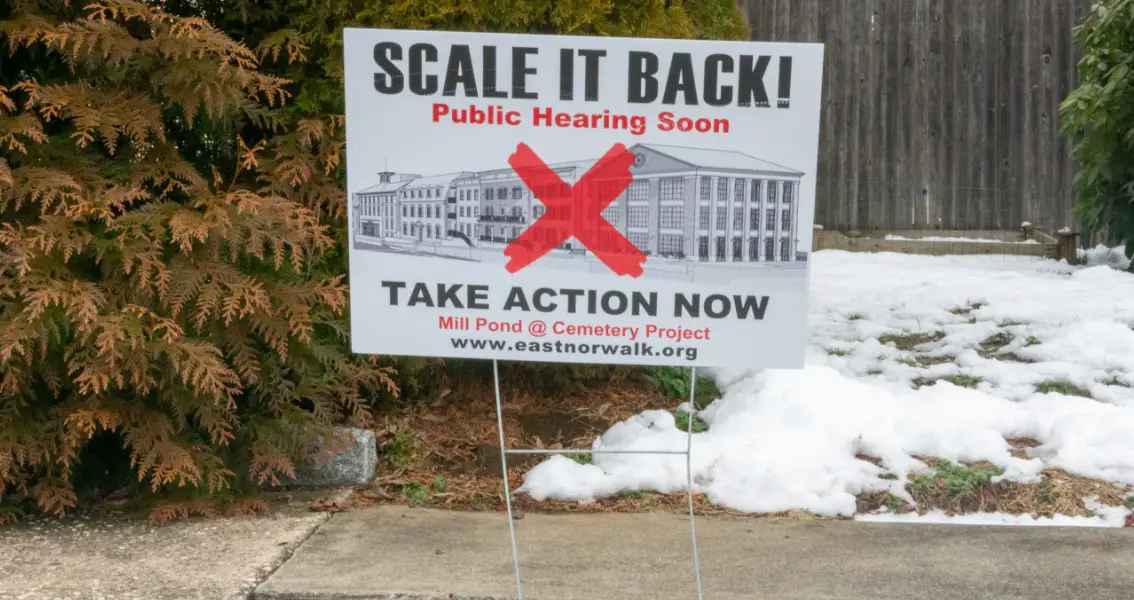Norwalk’s Cemetery Street project grinds forward

In a 6-2 vote on March 22, the Norwalk Planning and Zoning Committee (PZC) approved a resolution granting a special permit for the developers of a 77-unit mixed-bedroom development at One Cemetery St. to move ahead.
The meeting was the third of a series which saw dozens of participants in person and more than a hundred tuning in via Zoom. The vast majority of residents who spoke during the public comment period, which took up the entirety of the meeting on March 15, opposed the plan as proposed.
The controversial project, situated across the street from the Norwalk Cemetery, sits within a Transit Oriented Development (TOD) district centered around the East Norwalk train station. The cemetery is the final resting place of a number of prominent figures from Connecticut history, and a marker near the train station notes that before the city was burned by the British during the Revolutionary War the first town hall stood somewhere near East Avenue.
The Mill Pond, which the project takes its name from, once powered industry using tidal power.
The proposal for the development, a joint effort between Norwalk-based M.F. DiScala & Co. and Spinnaker Realty, calls for the construction of a five-story building and a smaller free-standing structure. In addition to 140 bedrooms, around 6,000 square feet of retail and office space anchoring end of the property is planned. A series of public amenities which earn “points”such as a public courtyard and an easement to provide access to a city owned parcel on the pond were included in the proposal to ensured developers can build to the height they seek.
“The vast majority of the opposition to this project isn’t about the project, it’s about the zoning,”attorney Adam Blank said during the developer’s response to public comments. “They’re unhappy with the East Norwalk Village TOD regulations, and that’s the primary gripe.”
“I think it’s a valid viewpoint to say, ˜I don’t want development in East Norwalk’ or ˜I don’t want East Avenue and Cemetery and Van Zant to change,'”Blank added. “That’s fine. But what’s in front of you isn’t a request for a zone change, it’s not a request for a variance, we’re asking you to fairly apply the existing East Norwalk Village TOD regulations to this application.”
Blank addressed several concerns from the public about the potential impact of the development on school enrollment, traffic flows, and the environment. While the PZC was for the most part convinced, the opposition was unmoved.
Diane Cece, a member of the board of the East Norwalk Neighborhood Association (ENNA), told the PZC on March 15 that while city regulations state that the public comments were to be addressed to applicants instead of the commission, they were appealing to them directly as it was the only way to affect their hoped for changes.
“The center of Norwalk is a diamond in the rough, and some small business activation and modest residential growth and beautification are all desired, however East Norwalk is neither a city downtown nor is it a major transit hub, but rather a small commuter station. The ENNA and residents recognize that while this application may meet the letter of the law in complying with the zoning regulations¦we contend that the application doesn’t meet the spirit of what residents intended or anticipated,”Cece said during public comment.
ENNA is a nonprofit that seeks to “preserve the residential character”of the neighborhood mounted an effort to prevent the approval of the development and the installation of traffic calming measures along Cemetery Street. An online petition circulated by the ENNA calling for the project to be scaled back (44 units permitted under as-of-right zoning is proposed by the ENNA) received over 770 digital signatures associated with individual emails.
ENNA launched a GoFundMe campaign seeking $11,000 to fund consultants and legal challenges. At the time of writing, 82 individuals have contributed to the fund which stands slightly above $8,000.
ENNA also petitioned the Connecticut Department of Energy and Environmental Protection (DEEP) for intervenor status, which forced the PZC to confer with city consul about the language of the legislation which created the status, allowing groups to oppose environmentally disruptive developments even if otherwise approved. However, the Norwalk PZC in the resolution took the stance that there was not sufficient evidence of major disruption and suggested that the DEEP did not need to become involved.